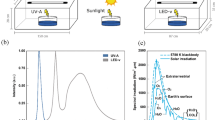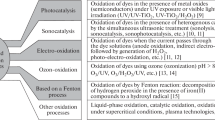Abstract
RDX (hexahydro-1,3,5-trinitro-1,3,5-triazine) is a highly toxic heterocyclic nitramine compound which enters the environment during manufacturing, disposal, or military training activities. This study aimed to evaluate the effectiveness of different treatment methods, including direct photolysis, photo-peroxidation, and the photo-Fenton oxidation, using low- and medium-pressure UV lamps for the degradation of RDX wastewater. Rate of degradation and mineralization of RDX, COD reduction, and nitrate content were compared for all these processes. In terms of RDX degradation, the study found that direct photolysis with 125-W medium-pressure UV lamp resulted in 71% removal rate. In contrast, the low-pressure UV lamp of 16 W intensity only showed removal rate of 35%. When comparing the UV/H2O2 process to direct photolysis, it was found that the degradation rate of RDX increased for both low- and medium-pressure systems. Among the different advanced oxidation processes evaluated, the photo-Fenton oxidation process resulted in the highest degradation of RDX compared to direct photolysis and photo-peroxidation processes. Specifically, the addition of 10 mL of Fenton’s reagent at a ratio of 1:3 (H2O2:Fe2+) resulted in 98% and 57% removal of RDX within 60 min of irradiation time for the medium-pressure and low-pressure UV lamps, respectively. The highest levels of mineralization for RDX in terms of COD and nitrate removal, amounting to 90% and 42%, respectively were obtained using photo-Fenton oxidation in 60 min of treatment time.









Similar content being viewed by others
Data Availability
The data can be available on request.
References
Bhanot, P., Celin, S. M., Kalsi, A., Singh, S. K., Sahai, S. K., & Sharma, P. (2021). Treatment of high explosive HMX (octahydro-1, 3, 5, 7-tetranitro-1, 3, 5, 7-tetrazocine) production effluent by advanced oxidation processes. International Journal of Environmental Science and Technology, 19, 1775–1784. https://doi.org/10.1007/s13762-021-03204-6
Boileau, J., Fauquignon, C., Hueber, B., et al. (2009). Ullman’s encyclopedia of industrial chemistry. Wiley-VCH Verlag GmbH & Co. Explosives. http://mrw.interscience.wiley.com/emrw/9783527306732/ueic/article/a10_143/current/pdf. July 27, 2009
Budavari, S., & O’Neil, M. J. (1989). The Merck index (p. 428). Merck & Co. Inc..
Buxton, G. V., Greenstock, C. L., Helman, W. P., & Ross, A. B. (1988). Critical review of rate constants for reactions of hydrated electrons, hydrogen atoms and hydroxyl radicals ·OH/·O− in Aqueous Solution. Journal of Physical and Chemical Reference Data, 17(2), 513–886. https://doi.org/10.1063/1.555805
Choi, J.-K., Son, H.-S., Kim, T.-S., Stenstrom, M. K., & Zoh, K.-D. (2006). Degradation kinetics and mechanism of RDX and HMX in TiO2 photocatalysis. Environmental Technology, 27(2), 219–232. https://doi.org/10.1080/09593332708618636
Cooper, J. K., Grant, C. D., & Zhang, J. Z. (2013). Experimental and TD-DFT study of optical absorption of six explosive molecules: RDX, HMX, PETN, TNT, TATP, and HMTD. The Journal of Physical Chemistry A, 117(29), 6043–6051. https://doi.org/10.1021/jp312492v
Crocker, F. H., Indest, K. J., & Fredrickson, H. L. (2006). Biodegradation of the cyclic nitramine explosives RDX, HMX, and CL-20. Applied Microbiology and Biotechnology, 73, 274–290. https://doi.org/10.1007/s00253-006-058R-y
EPA. (2006). Drinking water standards and health advisories. U.S. Environmental Protection Agency https://agri.idaho.gov/main/wpcontent/uploads/2018/03/epa_drinking_water_standard-2006.pdf
EPA (SW 846) (2006). Method 8330B Nitroaromatics, nitramines, and nitrate esters by high performance liquid chromatography (HPLC). https://www.epa.gov/sites/production/files/2015-07/documents/epa-8330b.pdf.
Gallard, H., De Laat, J., & Legube, B. (1999). Spectrophotometric study of the formation of iron(III)-hydroperoxy complexes in homogeneous aqueous solutions. Water Research, 33(13), 2929–2936. https://doi.org/10.1016/s0043-1354(99)00007-x
Ghaly, M. Y., Härtel, G., Mayer, R., & Haseneder, R. (2001). Photochemical oxidation of p -chlorophenol by UV/H2O2 and photo-Fenton process. A comparative study. Waste Management, 21(1), 41–47. https://doi.org/10.1016/s0956-053x(00)00070-2
HSDB. Hazardous Substances Data Bank. National Library of Medicine; (2009). Cyclonite. July 29, 2009.
Kan, E., Koh, C.-I., Lee, K., & Kang, J. (2014). Decomposition of aqueous chlorinated contaminants by UV irradiation with H2O2. Frontiers of Environmental Science & Engineering, 9(3), 429–435. https://doi.org/10.1007/s11783-014-0677-6
Khue, D. N., Lam, T. D., Van Chat, N., Bach, V. Q., Minh, D. B., Loi, V. D., & Van Anh, N. (2014). Simultaneous degradation of 2,4,6-trinitrophenyl-N-methylnitramine (Tetryl) and hexahydro-1,3,5-trinitro-1,3,5 triazine (RDX) in polluted wastewater using some advanced oxidation processes. Journal of Industrial and Engineering Chemistry, 20(4), 1468–1475. https://doi.org/10.1016/j.jiec.2013.07.033
Kiruthiga, R., & Sampath Kumar, V. (2015). Treatment of textile dyeing wastewater by applying photo-Fenton oxidation technology. International Journal of Science and Engineering Research, 3(6), 3221.
Kusic, H., Koprivanac, N., & Bozic, A. L. (2006). Minimization of organic pollutant content in aqueous solution by means of AOPs: UV- and ozone-based technologies. Chemical Engineering Journal, 123(3), 127–137. https://doi.org/10.1016/j.cej.2006.07.011
Mahbub, P., & Nesterenko, P. N. (2016). Application of photo degradation for remediation of cyclic nitramine and nitroaromatic explosives. RSC Advances, 6(81), 77603–77621. https://doi.org/10.1039/c6ra12565d
Mary Celin, S., Pandit, M., Kapoor, J. C., & Sharma, R. K. (2003). Studies on photo-degradation of 2,4-dinitro toluene in aqueous phase. Chemosphere, 53(1), 63–69. https://doi.org/10.1016/s0045-6535(03)00358-8
Morley, M. C., Henke, J. L., & Speitel, G. E. (2005). Adsorption of RDX and HMX in rapid small-scale column tests: Implications for full-scale adsorbers. Journal of Environmental Engineering, 131(1), 29–37. https://doi.org/10.1061/(asce)0733-9372(2005)131:1(29)
Pereira, V. J., Linden, K. G., & Weinberg, H. S. (2007). Evaluation of UV irradiation for photolytic and oxidative degradation of pharmaceutical compounds in water. Water Research, 41(19), 4413–4423. https://doi.org/10.1016/j.watres.2007.05.056
Stasinakis, A. S. (2008). Use of selected advanced oxidation processes (AOPs) for wastewater treatment – a mini review. Global NEST Journal, 10(3), 376–385.
Su, H., Christodoulatos, C., Smolinski, B., Arienti, P., O’Connor, G., & Meng, X. (2019). Advanced oxidation process for DNAN Using UV/H2O2. Engineering, 5(5), 849–854. https://doi.org/10.1016/j.eng.2019.08.003
Terracciano, A., Christodoulatos, C., Koutsospyros, A., Zheng, Z., Su, T. L., Smolinski, B., Arienti, P., & Meng, X. (2018). Degradation of 3-nitro-1,2,4-trizole-5-one (NTO) in wastewater with UV/H2O2 oxidation. Chemical Engineering Journal, 354, 481–491. https://doi.org/10.1016/j.cej.2018.07.216
Tony, M. A., Zhao, Y. Q., Purcell, P. J., & El-Sherbiny, M. F. (2009). Evaluating the photo-catalytic application of Fenton’s reagent augmented with TiO2and ZnO for the mineralization of an oil-water emulsion. Journal of Environmental Science and Health, Part A, 44(5), 488–493. https://doi.org/10.1080/10934520902719894
U.S. Army. Volume 2: RDX/HMX production. Frederick, MD: U.S. Army Medical Research and Development Command, Fort Detrick; (1978). Specific air pollutants from munitions processing and their atmospheric behavior. ADA060122. (Author: Carpenter BH et al.)
U.S. Army. Water quality criteria for hexahydro-1,3,5-trinitro-1,3,5-triazine (RDX). Frederick, MD: U.S. Army Medical Research and Development Command; 1986. (author: Etnier EL).
Zappi, M. E., Hernandez, R., Gang, D., Bajpai, R., Kuo, C. H., & Hill, D. O. (2016). Treatment of groundwater contaminated with high levels of explosives using advanced oxidation processes. International Journal of Environmental Science and Technology, 13(12), 2767–2778. https://doi.org/10.1007/s13762-016
Acknowledgements
The support and encouragement provided by Director Centre for Fire Explosive and Environment Safety (CFEES), DRDO, India, is greatly acknowledged.
Author information
Authors and Affiliations
Contributions
All authors contributed to the study conception and design. The first draft of the manuscript was written by Pallvi Bhanot and all authors commented on previous versions of the manuscript. All authors read and approved the final manuscript.
Corresponding author
Ethics declarations
Ethics Approval and Consent to Participate
Not applicable.
Consent for Publication
Not applicable.
Conflict of Interest
The authors declare no competing interests.
Additional information
Publisher’s Note
Springer Nature remains neutral with regard to jurisdictional claims in published maps and institutional affiliations.
Rights and permissions
Springer Nature or its licensor (e.g. a society or other partner) holds exclusive rights to this article under a publishing agreement with the author(s) or other rightsholder(s); author self-archiving of the accepted manuscript version of this article is solely governed by the terms of such publishing agreement and applicable law.
About this article
Cite this article
Bhanot, P., Celin, S.M., Sharma, P. et al. Comparative Evaluation of Low- and Medium-Pressure UV Lamps for Photo-degradation of RDX Wastewater. Water Air Soil Pollut 234, 587 (2023). https://doi.org/10.1007/s11270-023-06602-3
Received:
Accepted:
Published:
DOI: https://doi.org/10.1007/s11270-023-06602-3




